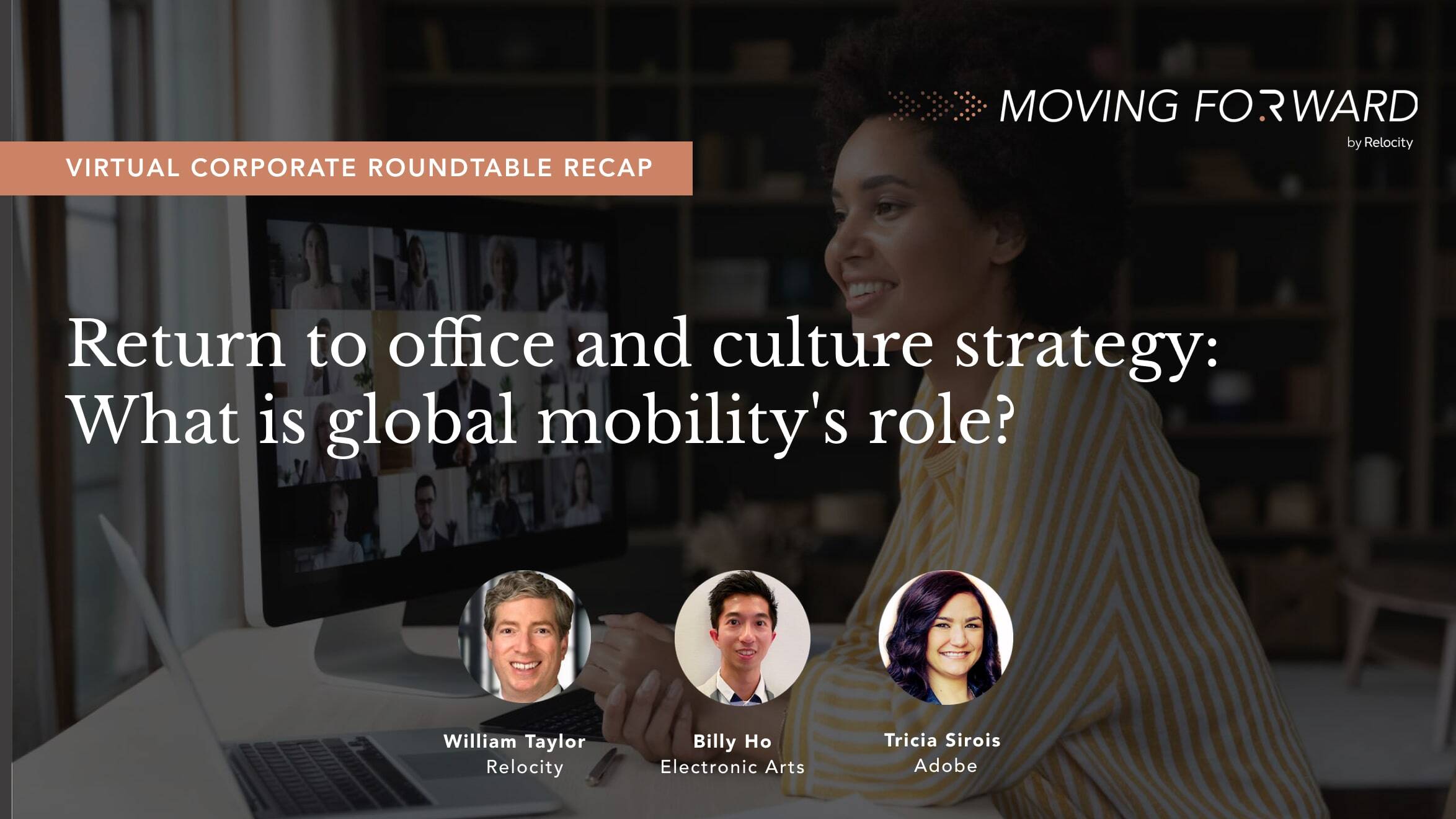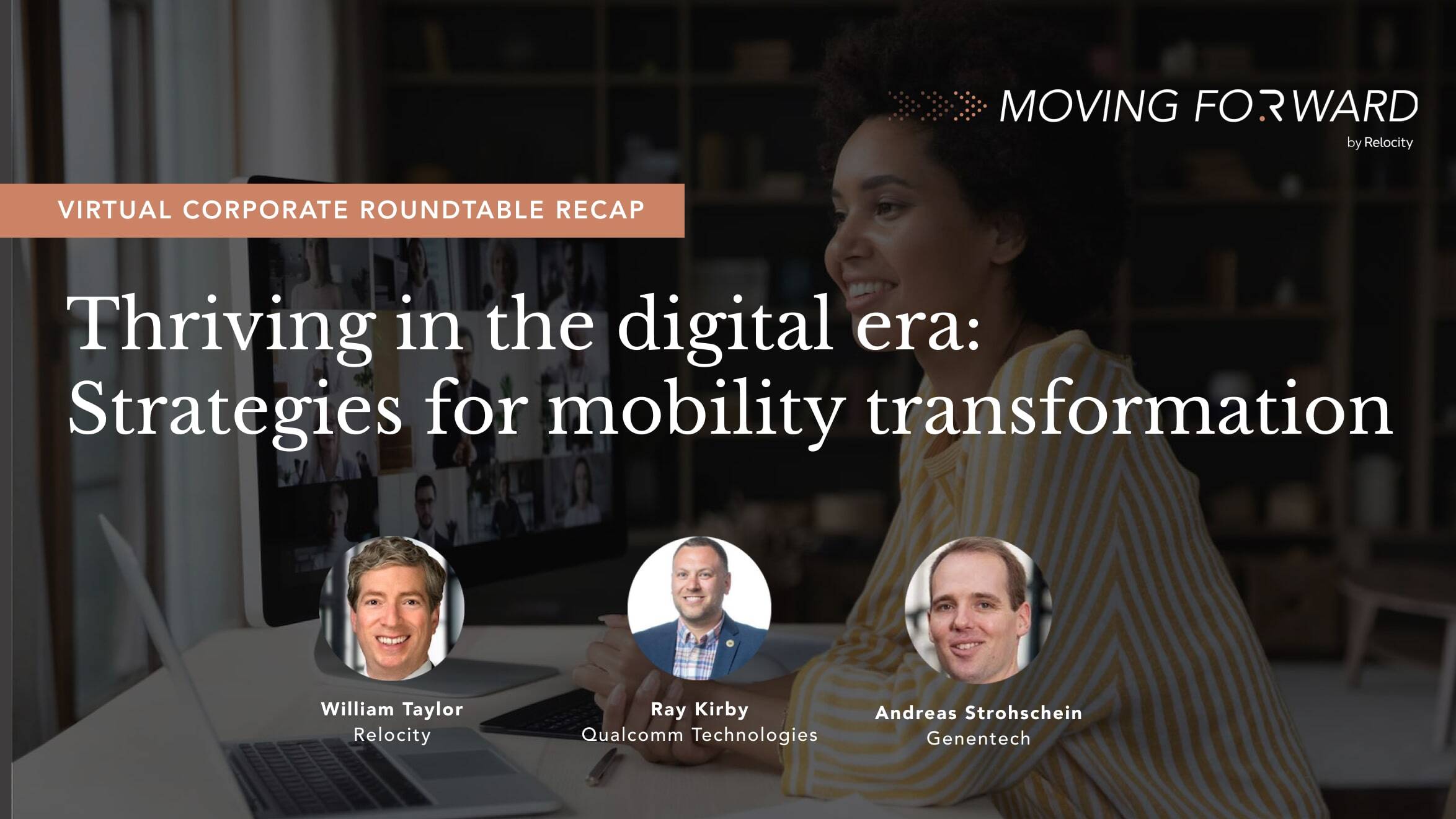10 takeaways from Relocity’s cost-cutting roundtable | Relocity
Relocity recently hosted our second virtual event as part of our corporate roundtable series: Moving Forward. These corporate roundtables bring...
4 min read
Relocity March 30, 2023

Relocity recently hosted our first virtual event as part of our corporate roundtable series: Moving Forward. Through these corporate roundtables, we’ll bring mobility professionals together to engage in open conversations and benchmarking around key topics.
On March 23, Billy Ho, Senior Manager of Talent Mobility at Electronic Arts (EA), and Tricia Sirois, Senior Manager of Global Mobility at Adobe, joined Relocity’s Head of Partnerships and Moving Forward host William Taylor to discuss mobility’s role in return to office (RTO) and remote work cultures.
We discovered how Ho and Sirois contributed to their employers’ respective RTO guidelines and explored how mobility professionals can support RTO initiatives with corporate culture, talent acquisition, and talent retention in mind. Here are five key takeaways from the roundtable.

The roundtable shed light on the importance of defining RTO and its objective. For instance, EA’s flexible work program doubles as a competitive workforce tactic to attract talent. Another matter to examine is how remote and flexible policies play into the RTO guidelines. Think holistically. Analyze the benefits of in-person and flexible work. Coming into the office enhances networking, rapport, and collaboration, while remote work increases productivity and connects geographically distant stakeholders.
If collaboration is the primary objective of assembling teams in-person, companies should consider replacing individual cubicles with open meeting areas. To encourage formal and casual gatherings, spruce up the kitchen with a bar area. Pair building improvements with planned incentive days to motivate employees to come into the office.
Ultimately, defining the purpose of RTO for your firm can create a more productive and fulfilling environment.

Another highlight of the roundtable was the discussion around RTO ownership. Which departments should be responsible for building and implementing the RTO strategy?
Consider teams with expertise on new ways of working, employee experience, company culture, and corporate policy, and bring in a consultant if necessary. Mobility professionals have the insight into flexible work required to own RTO and should at least have a seat at the table.
In terms of execution, each business unit should drive its own RTO and remote work standards and criteria to ensure consistency. Mobility teams can take on a coaching role to help business units understand the best RTO strategy for each job.
Employers should also support flexible work by:
• Contributing to each individual’s remote office setup, including technology to prevent Wi-Fi issues and the like.
• Accounting for the legality of employees working where there is no corporate entity. One of our roundtable attendees shared that their legal and payroll teams decide whether employees can work from places without corporate offices.
Ho advised there's no one-size-fits-all solution for a flexible work program or RTO strategy, so employers should stay flexible when implementing these plans. The vision may look different in practice. By figuring out the right team to develop guidelines, companies can create a successful and flexible return to office strategy that meets the needs of the business and employees.

Both Ho and Sirois emphasized the importance of analyzing data to understand how RTO should look for different firms. “Let data drive the RTO strategy,” said Ho. The type of data to collect may vary by business unit, role, office location, and more.
Data helps employers understand:
• If the footprint of an office is necessary.
• If so, how much office space they need.
• Which modifications to make to the building based how firms want each team to grow.
The type of data to collect can include:
• Site occupancy.
• Site usage.
• The amount of employees who come in on a regular basis.
• Patterns; for instance, if the same team comes in on a regular cadence.
• The most-used office spaces.
Such data proved useful in helping EA’s executive team recently decide to build new offices in Danville, California and Vancouver, Canada.

Another takeaway from the roundtable is that employers should consider enhancing employee benefits to incentivize RTO. While RTO’s focus is on getting teams back to their assigned work locations, firms must remember the impact of work-life balance, flexibility, and wellness on the employee experience. For example, Adobe leadership, despite rolling out a RTO plan that requires employees to be in the office 50% of the time in January 2023, still encourages flexible work, in alignment with the corporate culture.
When determining which benefits to offer, our attendees seemed to make a distinction between business-driven moves and employee-requested relocations. The consensus was RTO doesn’t necessitate relocation benefits.
Sirois shared that Adobe doesn’t provide benefits for personal domestic moves. However, the company’s approach is more nuanced if an international move has business justification. Overall, companies should ensure their RTO guidelines enable flexibility, work-life balance, and wellness to ensure employee satisfaction and retention.

As the discussion evolved, attendees started talking about the importance of reviewing working abroad guidelines. One attendee reported that her company involved 30 stakeholders in the working abroad decision-making process in February 2022, underscoring the importance of keeping guidance current.
We heard a range of recommendations around working abroad, with some companies allowing 20-30 business days per year and feeling pressure to increase that number. Sirois shared that Adobe has a strict policy (yes, they call it a formal “policy”) of 15 business days working domestically and 20 business days working internationally, with employees exceeding these limits being asked to use time off.
To ensure compliance with working abroad guidelines, some companies require employees to fill out a “work location change” form and assess whether or not to change the processing of permanent visas and labor condition applications to include corporate office location and home office location.
A tough nut to crack seems to be enforcing working abroad policies. Some companies rely on manager oversight, while others use self-identification as the only form of enforcement. To meet the needs of their employees and business goals while ensuring compliance, companies should regularly review the working abroad guidance.

RTO isn’t as simple as mandating employees’ presence in the office anymore. A number of factors — such as office layout, legal requirements, company growth plans, and talent expectations — impact RTO’s success. Employers can successfully get their top talent in the same room again by:
• Defining what RTO means to their firms and the purpose of in-office work.
• Building their RTO strategies with key stakeholders.
• Analyzing RTO key performance indicators.
• Considering enhancing employee benefits to incentivize RTO.
• Reviewing working abroad guidelines and updating them if necessary.
Thanks for checking out our RTO conversation. Stay tuned for information about our next virtual corporate roundtable about cost savings in May 2023.
Book a demo to see how Relocity can support your RTO strategy.

Relocity recently hosted our second virtual event as part of our corporate roundtable series: Moving Forward. These corporate roundtables bring...
![[Recap] Relocity’s roundtable on ESG | Relocity](https://www.relocity.com/hubfs/Imported_Blog_Media/64a7350ce778a81576d7ba21_RTO%20Recap%20Blog%20Main%20-%20ESG-min-1.jpg)
Relocity recently hosted our third virtual event as part of our corporate roundtable series: Moving Forward. These corporate roundtables bring...

At Relocity’s latest corporate roundtable in the Moving Forward series on June 11, key industry leaders discussed technology's impact on relocation. ...